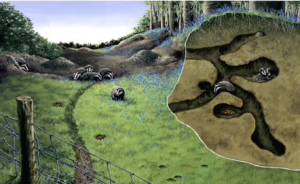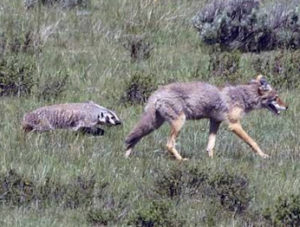In varied landscapes of Texas, like on a client property in Mason County, landowners share their space with an array of native wildlife, including the resilient and intriguing American Badger (Taxidea taxus). Known for their distinctive appearance and fearless nature, badgers are more than just the tough characters of the animal kingdom; they are fascinating examples of adaptation and survival.
The Native Texan: American Badger
The American Badger, a member of the Mustelidae family—which also includes otters, ferrets, and wolverines—is not just a visitor but a native inhabitant of Texas. With their distinctive low-slung bodies, powerful digging limbs, and striking black-and-white facial markings, badgers are a unique part of Texas’s wildlife. They are primarily nocturnal creatures that spend much of their time in underground burrows or setts, which serve as protection and living quarters.
Habitat and Distribution in Texas
Badgers are adaptable and can thrive in various environments, but in Texas, they are more commonly found in the western and northern regions. These areas offer the open fields and sparse woodlands that badgers prefer, providing ideal conditions for hunting and burrowing. The soil in these parts of Texas is particularly suited to their lifestyle, facilitating the creation and maintenance of their extensive underground homes.
Diet, Hunting, and Ecological Role
Badgers are carnivorous, with a diet that primarily consists of small mammals, including rodents, rabbits, and ground squirrels. Their hunting technique is a testament to their determination and physical prowess. Using their powerful claws, they dig into the burrows of their prey, showcasing an unmatched persistence.
What sets the American badger apart in the animal kingdom is their occasional partnership with the coyote—a remarkable example of interspecies cooperation. While the badger can dig out prey that hides underground, the coyote can chase down those that escape onto the open ground, making their hunting sessions surprisingly effective.
Conservation and Coexistence with American Badgers
While the American Badger is currently classified as Least Concern by the IUCN Red List, indicating a stable population, they face challenges from habitat destruction, road mortality, and conflicts with human activities. For Texas landowners, understanding these challenges is crucial for badger conservation. Efforts to protect their habitats and mitigate conflicts can help ensure badgers continue to be a part of Texas’s ecosystem.
American Badgers, while not typically dangerous to humans, are wild animals with a natural instinct to defend themselves if threatened or cornered. They are known for their fearless nature and will stand their ground against much larger animals. However, badgers generally prefer to avoid human interaction and are unlikely to pose a threat under normal circumstances. It’s always wise to maintain a respectful distance from any wild animal, including badgers, to avoid any potential risks.
Quick Facts About American Badgers:
- Impressive Diggers: Badgers are exceptional diggers thanks to their powerful forelimbs and strong claws. They can dig into hard ground with remarkable speed and efficiency, creating burrows in a matter of minutes.
- Built for the Hunt: Their bodies are low to the ground, which helps them stay close to their prey’s scent trails. This body shape, combined with their powerful build, makes them formidable hunters.
- Nocturnal and Solitary: Badgers are primarily active at night, and aside from mothers with young or occasional partnerships with coyotes for hunting, they lead solitary lives.
- Interspecies Cooperation: One of the most fascinating aspects of badger behavior is their occasional hunting partnerships with coyotes. This unusual alliance benefits both species, as they can catch more prey by working together.
- Long Lifespan: In the wild, American Badgers can live up to 14 years, which is quite long for a medium-sized mammal.
- Versatile Diet: While badgers primarily hunt small mammals, they are opportunistic feeders and will also eat birds, reptiles, insects, and even some plant matter.
- Important Ecological Role: Beyond controlling rodent populations, their burrowing activity plays a crucial role in soil aeration and can help in seed dispersal, contributing to a healthy ecosystem.
- Distinctive Markings: The bold, white stripe that runs from their nose over the back of their head is one of the most distinctive features of American Badgers, making them easily recognizable.
- Seasonal Behavior: Badgers do not hibernate but may become less active during the winter months, depending on the local climate and food availability.
- Communication: They communicate with each other through a variety of sounds, including growls, hisses, and barks, as well as through scent marking.
A Shared Texas Heritage
For landowners in Texas, the presence of the American Badger on their land signifies a healthy, balanced ecosystem. Recognizing badgers as native inhabitants and understanding their habits and ecological role are key steps toward ensuring their continued presence in Texas.
Drawing from sources like the IUCN Red List, National Geographic, and the Wildlife Society, this guide aims to provide Texas landowners with a comprehensive understanding of the American Badger, emphasizing the importance of conservation and positive coexistence in our shared environment.











